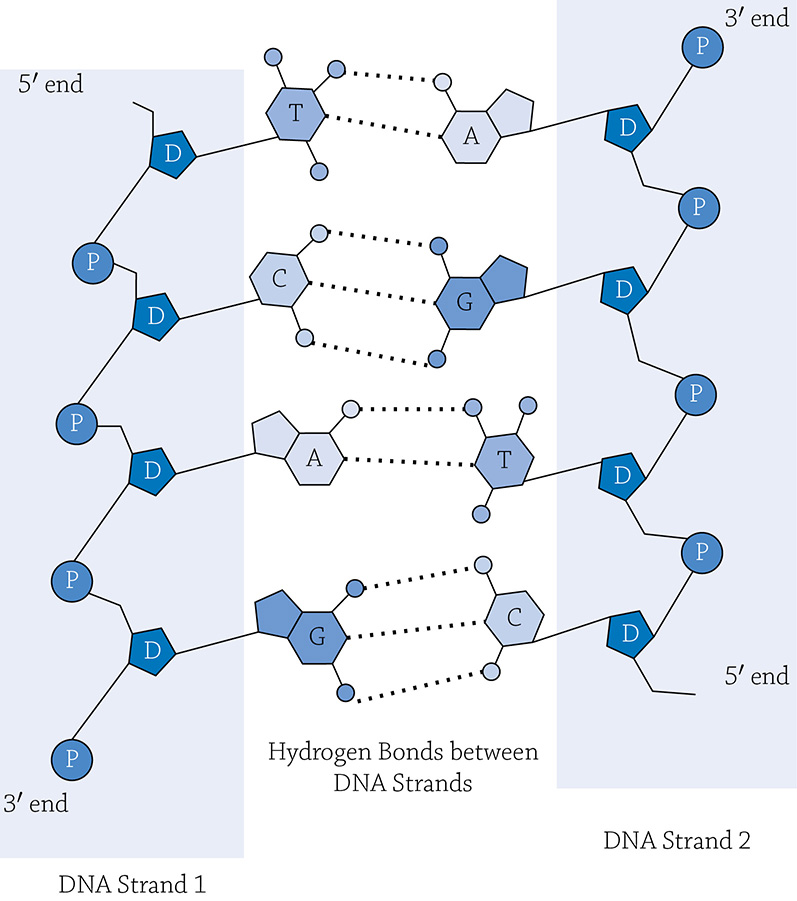Must Know High School Biology - Kellie Ploeger Cox 2019
PART THREE Genetics
Replication of DNA
MUST ![]() KNOW
KNOW
![]() The double-stranded nature of DNA allows for stability and heritability.
The double-stranded nature of DNA allows for stability and heritability.
Ilove this must know concept. It blew my mind when I first thought about it. DNA is double stranded, right? But why? You’re soon going to learn about the process of correctly copying both strands of DNA, and when expressing a gene, carefully selecting the one strand that actually carries the correct protein code. It seems that it would be so much simpler if there was only one strand of DNA to deal with. But the double strandedness of DNA is the reason it can be inherited. In order to fully explain this concept, we have to first learn some of the mechanics of DNA replication.
All cells come from preexisting cells. When a cell divides, it must first create a perfect copy of its DNA. When the cell then splits in half, both of the new “daughter cells” will have a full complement of DNA, identical to the original cell. The process of the cell copying all of its chromosomes is called DNA replication. The process is fairly simple and straightforward.
Helicase
An enzyme called helicase unwinds and unzips the double-stranded chromosome. When the two strands separate, the sugar-phosphate backbone remains completely intact; instead, the weaker hydrogen bonds between the base pairs are broken. The two strands now have exposed hydrogen bonding that wants to snap back together, so proteins called single-stranded binding proteins latch onto the unpaired nitrogenous bases to keep the two strands apart. The point at which the DNA is “unzipped” (meaning the hydrogen bonds between the base pairs are broken) is called the replication fork.

A replication fork created by helicase and maintained by single-stranded binding proteins
DNA Polymerase
Another enzyme called DNA polymerase (please refer to labeled A in the following figure) matches up free nucleotides (B) that are complementary to the unzipped (exposed) DNA template. These free nucleotides are always available, floating around inside the nucleus.

DNA replication
DNA polymerase can match about 50 nucleotides every second! Not only is it fast, DNA polymerase is very good at its job and rarely makes a matching error (if there is a mistake, it quickly fixes it). When all is said and done, there is only around 1 mistake per 1 billion nucleotides. DNA polymerase, however, needs a bit of help getting the process started. In order to add a new nucleotide, there must be a free 3′-hydroxyl (-OH) group to add onto. This sounds confusing, but just look closely at the ends of a piece of DNA:

A strand of DNA showing basic structure. Notice the 5′ and 3′ ends of a strand of DNA.
Author: Boumphreyfr. This file is licensed under the Creative Commons Attribution-Share Alike 3.0 Unported license. https://commons.wikimedia.org/wiki/File:Dna_strand.png.
The enzyme DNA polymerase adds a new nucleotide through a dehydration reaction, which needs an −OH group to react with. That’s why it can’t just start a new strand of DNA from scratch; it can only add to an −OH group that’s already there. Luckily there’s another enzyme called primase to the rescue! Beforehand, it will put down a tiny bit of RNA (called a primer) to provide a necessary free-hanging 3′-hydroxyl group (please refer back to part C in the figure that shows DNA replication). Once replication is finished, another DNA polymerase will swoop in and swap out the RNA for DNA. A final enzyme called ligase will glue together the fragments of DNA to create a nice, new, intact DNA strand.
Notice that the two strands of a DNA molecule that base-pair with one another are antiparallel, meaning they run in opposite directions. This is significant for DNA polymerase to do its job, because it creates what is called a leading strand and a lagging strand. The leading strand (D) is the simpler strand to synthesize because it requires only one jumping off point—one piece of RNA to serve as a primer. Then, as the DNA unzips, it frees up the 3′-end of the new, growing strand of DNA; DNA polymerase has an easy time adding new nucleotides onto that 3′ end. The lagging strand (E), however, needs multiple primers because of the positioning of the 3′ hydroxyl group that DNA polymerase so desperately needs. When the DNA unzips, the 5′ end of the new growing strand of DNA is exposed—DNA polymerase cannot add onto that end! Instead, it has to wait for a new primer to be added (F).
Dehydration Reaction
As mentioned before, a covalent bond (specifically called a phosphodiester bond) forms between the newly added nucleotide and the growing (new) strand of DNA after a dehydration reaction occurs. This is commonly how monomers of a larger polymer are “glued” together. The word dehydration gives a clue to how this reaction proceeds … to dehydrate something means to remove water!

Linking together nucleotides using a dehydration reaction
Two Identical Chromosomes
Once the process is complete, there will be two identical double-stranded chromosomes, each composed of one of the original DNA strands and one strand that is composed entirely of new nucleotides attached by DNA polymerase. This is called the semiconservative model of DNA replication.
Okay, now we can relate this back to our must know concept. DNA replication seems so difficult, considering the 3′ and 5′ ends, and subsequent leading and lagging strands. It would be simpler if a cell only had to copy one strand of DNA, right? But then what would that replicated piece of DNA look like? Would it be genetically identical to the original, and would the resulting daughter cell get the exact same DNA as the original cell? Nope. Because of complementary base pairing, if the original strand’s DNA sequence was this:
ACGTTACACAGGG
then the copied DNA would be this:
TGCAATGTGTCCC
Not identical at all! Complementary, yes, but not identical. And when a cell replicates its DNA, it has to be exactly the same. This is taken care of if DNA is a double-stranded molecule made of two complementary strands of DNA. When both strands are replicated, you get another double-stranded DNA molecule, genetically identical to the first. Another important consideration has to do with the stability of the molecule. A single-stranded molecule of nucleic acid (whether its DNA or RNA) isn’t very stable; it will degrade quickly. You know what you don’t want your DNA to do? Degrade. A double-stranded molecule is much more stable … and that’s a good thing.
REVIEW QUESTIONS
1. What must occur before a cell divides?
2. The double-helical structure of DNA is antiparallel. This means that the 3′ end of one strand (which has a _______ group hanging off of it) must line up with the _______ end of the complementary strand (which has a phosphate group hanging off of it).
3. Which strand needs multiple RNA primers in order for DNA polymerase to create a complementary copy: leading strand or lagging strand?
4. Free nucleotides are added to a growing strand of DNA through a _______ reaction, which creates a new _______ bond.
5. Why, exactly, can DNA polymerase only attach free nucleotides to the 3′ end of a growing DNA molecule?
6. Fill in the blanks with the correct term: DNA polymerase, helicase, ligase, primase, single-stranded binding proteins.
a. The enzyme _______ unwinds and unzips DNA in order for replication to occur.
b. The enzyme _______ must first synthesize a small piece of RNA in order for another enzyme to begin adding DNA nucleotides to the growing strand.
c. Once DNA is unzipped, _______ stick to the unpaired bases in order to keep the two strands apart.
d. The enzyme _______ glues together fragments of newly synthesized DNA by creating new phosphodiester bonds.
e. The bulk of the work of creating a new strand of DNA is done by_______, the enzyme responsible for pairing up complementary nucleotides.
7. What are the two reasons DNA must be double stranded?
8. Which of the following statements correctly describes the semi-conservative model of DNA replication? Once DNA is copied, it will have:
a. Two strands, both from the original DNA molecule
b. One strand from the original DNA molecule and one created from new nucleotides
c. Two strands, both created from new nucleotides
9. True or False: Because of the need for primers during DNA replication, the daughter cell’s chromosomes will contain some RNA fragments.
